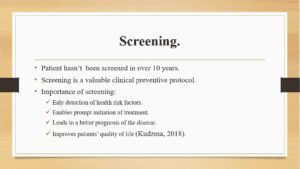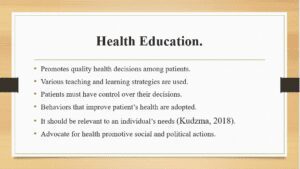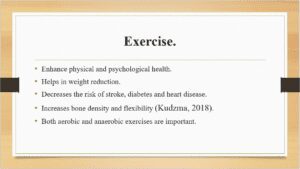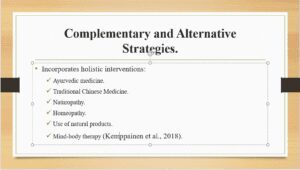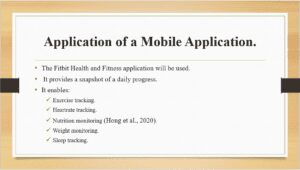Interventions of Health Screening
Hello and welcome to today’s session. The session aims to discuss health issues identified in our case study. The discussion focuses on factors that relate to the health oncers of the patient in our case study—examples of these factors are Exercise, stress management, health education, and screening. Get in touch with us at eminencepapers.com. We offer assignment help with high professionalism.
This is the outline of the presentation. We will start by discussing the importance of screening and how it relates to the patient’s health. We will then look at health education and nutritional counseling for health promotion. Next, the relevance of exercise and stress management will be discussed. After that, complementary and alternative strategies will be discussed. Finally, we will discuss the use of a mobile application that is relevant to the well-being- of the patient.
Screening is performed to facilitate the detection of potential health disorders or diseases in asymptomatic persons. The screening goals are early detection of diseases, initiating lifestyle changes and surveillance, setting up strategies to minimize the risk of illness, and initiating prompt and effective treatment. Screening tests are not diagnostic; they identify the population that requires additional testing to determine existential conditions or confirm their absence. Screening enables people to make critical, informed decisions concerning their health behaviors (Kudzma, 2018). Screening of the 52-year-old patient revealed that he was unaware of his immunizations. This necessitates a look into his medical history because it could not be established whether he had received all his childhood vaccinations. Immunization enables the body to develop antibodies against a particular disease; hence, the person gains immunity.
Further screening revealed that he had a cough with whitish sputum, experienced wheezing while walking, and was hypertensive, with a blood pressure of 160/80. Furthermore, he smoked about two cigarette packets daily, taking 5-6 beers daily. These results form the basis for prompt initiation of therapy and education on the need for lifestyle modification.
Health education aims at helping individuals and the community achieve optimal health by incorporating various initiatives. It facilitates voluntary health-promotive actions. By so doing, health education improves health literacy. It provides information and facilitates health-related changes in behavior. It involves using teaching-learning strategies, enabling patients to maintain autonomy over their decisions.
Furthermore, it emphasizes behavior changes that improve health status. The behavioral and social cognitive theories are primarily used in health education. Health education should emphasize socio-political actions that uphold health in communities and individuals (Happy People, 2020). The patient should be educated on his disease process and the case study. The cough, whitish sputum, wheezing, and heartburn indicate an underlying respiratory infection. It could mean the development of chronic obstructive pulmonary disease COPD. Mr. Collins’ social history reinforces the likelihood of COPD: a 2 PPD smoker. His health education should include strategies to prevent the progress of his disease, such as quitting smoking.
Proper nutrition helps to avert dietary-related complications such as coronary heart disease, diabetes mellitus, obesity, and hypertension. Fruits and vegetables, foods with saturated animal fats, and sugary foods should be avoided. Small portions should be consumed rather than binge eating (Kudzma, 2018). Dietary reference intake (DRI) guidelines serve as a guide for proper nutrition and the establishment of nutrition and health policies. DRIs are used for planning and assessing the diets of individuals and provide a scientific basis for food intake guidelines (Kudzma, 2018). In the case study, the patient takes multiple cups of coffee per day, drinks 4 cups of coffee daily, and consumes fast foods. The patient reports to be consuming 5 to 6 bottles of beer per day. The patient should be educated on the importance of minimizing the consumption of sugary foods. He should reduce the number of sods and cups of coffee consumed. Processed foods should be avoided. He should consume fruits and vegetables daily. This modification of his diet will help to manage his hypertension( his blood pressure reading is 160/80). Furthermore, he should minimize the amount of alcohol consumed or quit drinking in totality.
Estimated average requirement refers to the median nutritional intake that fulfills the dietary needs of half of people of a specific gender or age bracket. It evaluates the sufficiency of nutrient intake of a particular group of people. Recommended dietary allowance refers to the mean dietary intake that meets the nutritional needs of approximately 98 percent of individuals in a specific gender group (Kudzma, 2018). Adequate intake provides an estimate of the average nutrient intake by a particular group of people. Adequate intake should fulfill the needs of a specific group of healthy people. Tolerable upper intake level refers to the highest mean daily information deemed safe for healthy individuals in a particular group (Kudzma, 2018). Acceptable macronutrient distribution range refers to the intake range for an energy source associated with a lower risk of chronic diseases. Estimated energy requirement means dietary intake expected to sustain energy balance in a healthy individual of a specific life stage.
Physical activity occurs when skeletal muscle contraction results in energy expenditure and body movement. Exercise refers to structured and continuous body movement to improve physical fitness (Kudzma, 2018). Aerobic Exercise refers to using muscle in a repetitive, rhythmic fashion to enhance the efficiency of the oxidative energy-producing system. Anaerobic Exercise occurs when high-intensity, short-duration activities improve the efficiency of the glycolytic energy-producing.
Systems. Physical fitness occurs when there is cardio-respiratory and muscular fitness. Regular physical activity can help maintain functional independence, resulting in a better quality of life as a person ages. The assessment of the patient revealed that he does not exercise after consuming processed and sugary foods. Since he is a plumber, his lifestyle is sedentary. The patient should be educated on the importance of aerobic and anaerobic Exercise. Regular Exercise will help the patient control his hypertension and improve his cardio-respiratory profile.
A stressor refers to any stimulus that disrupts the body’s normal state, thereby requiring change. Stress has various etiological factors: psychological factors, environmental, physiological factors, and spiritual factors. Poorly managed stress can exacerbate disease or lead to a new condition. Pro-inflammation linked to stress causes various conditions such as asthma, angina, pain, tension headaches, and gastrointestinal (Kudzma, 2018). Stress can produce Hyperactivity or the hypoactivity of hormones the neuroendocrine system regulates. Stress management improves the quality of life by increasing healthy, effective coping; This reduces the unhealthy impacts of distress. Stress management produces an interaction of mind, body, and spirit, promoting physical health and well-being. Stress management is an essential tool for nursing practice. To facilitate the achievement of the goals of Healthy People 2020, critical reasoning should be used to examine factors contributing to symptom development. Stress mitigation strategies include stress self-awareness, relaxation techniques such as Yoga, meditation, and guided imagery. Acupuncture, acupressure, hypnosis, and aroma therapy can also be used in stress management. The patient should be self-aware of the sources of his stress. This can be achieved by monitoring the warning signs of stress. The disease process itself can be a stressor. After that, his stress should be managed accordingly.
The stress-coping abilities of an individual, family, or community are part of a comprehensive health assessment that includes past and present subjective and objective data. These data help the individual and the nurse to determine the status of the person’s stress-coping pattern and actual and potential strengths and weaknesses (Kudzma, 2018). The nurse collects the patient’s data during history taking, physical examination, and assessment of health patterns. Stress is experienced across biological, psychosocial, and spiritual domains. All perceptions have a significant impact on the assessment. Primary appraisal of coping with stress entails descriptions of actevaluationtential positive or negative outcomes (Kudzma, 2018). Negative consequences include physical injury, and diseases. Positive results have adverse effects on essential relationships. Secondary appraisal affects primary appraisal. They consists a person’s identification of choices associated with potential harm. This consists of internal or external resources and responsibilities. All of these data options will help in the title of the potential stressors of the patient.
Complementary therapy refers to the use of complementary and alternative Medicine in conjunction with allopath signal Medicine (Kemppainen et al., 2018). Alternative therapy is the use of Complementary and Alternative Medicine (CAM) in treatment. Integrative therapy entails evidence-based instead of conventional Medicine. Integrative therapy emphasizes zones of safety and effectiveness (Kemppainen et al., 2018). Ayurvedic Medicine integrates CAM modalities such as herbs and massage to balance the body, mind, and spirit. By so doing, diseases are prevented. Ayurvedic Medicine operates on the beliefs that all living and nonliving things are work in harmony. Reasonable health beliefs, when the mind and body are in harmoTraditional Chinese Medicine incorporates herbs, acupuncture, and complementary and alternative medicine tree theoretical frame and ork of Traditional Chinese Medicine entails the complementary yet opposing yin and yang life forces. In naturopathy practitioners instead use a variety of CAM modalities. Adopting a healthy lifestyle, using noninvasive treatments, and strengtheAdoptingre emphasized. Homeopathy is based on the following principles: like cures, the more a remedy is diluted, the greater the potency and illness SPC to the individual. Treatment is not directed at the symptoms but on the person as a whole. Mind-body therapy involves use of techniques such as meditation imagery.
The Fitbit app runs in the background of the mobile phone to keep people enabling automatic syncing and application notifications from their phone. The app allows for n tracking heart rate, weight, and nutrition monitoring (Honallows for., 2020). It is rare for the patient because of lifestyle modifications, including dietary changes and regular Exercise. The patient will monitor his exercise history and food intake to help improve his well-being.
ORDER A PLAGIARISM-FREE PAPER HERE
We help with everything from well-being on
Group PPT – Each group member will submit a copy of your group’s Voice Over PowerPoint presentation in the drop-box for grading.
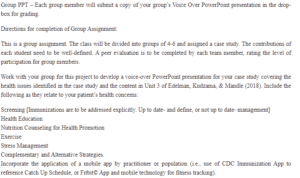
Interventions of Health Screening
Directions for completion of Group Assignment:
This is a group assignment. The class will be divided into groups of 4-6 and assigned a case study. The contributions of each student need to be well-defined. A peer evaluation is to be completed by each team member, rating the level of participation for group members.
Work with your group for this project to develop a voice-over PowerPoint presentation for your case study covering the health issues identified in the case study and the content in Unit 3 of Edelman, Kudzama, & Mandle (2018). Include the following as they relate to your patient’s health concerns:
Screening [Immunizations are to be addressed explicitly. Up to date- and define, or not up to date- management]
Health Education
Nutrition Counseling for Health Promotion
Exercise
Stress Management
Complementary and Alternative Strategies.
Incorporate the application of a mobile app by practitioner or population (i.e., use of CDC Immunization App to reference Catch Up Schedule, or Fitbit© App and mobile technology for fitness tracking).
Presentation criteria:
Work in your group.
All students participate in the presentation, doing their voice-over for PowerPoint slides.
A 10-minute Voice Over PPT presentation will be uploaded by one group member toOne group member will upload a 10-minute Voice Over PPT presentationCaucasian male who reports today for an annual exam for insurance purposes. He has not seen a provider in over ten years. He states he is in good health but has noticed his feet swelling more lately. He also reports his heart “skipping” beats but has not seen anyone about this. He denies taking any medications.
Allergies: Penicillin
Current medications: BC powder
PMH: GERD
PSH: Tonsillectomy
Social: Tobacco: 2 PPD smoker, Alcohol 5-6 beers daily, Denies illegal drug use. Drinks 4 cups of coffee, multiple sodas a day, 2-3 bottles of water, eat fast food during the week, Does not exercise, Works as a plumber.
Immunizateatss: Does not remember
Family: Father: died at 67 from MI; Mother: alive, + HTN, Hyperlipidemia, CKD stage II
ROS:
Constitutional: Well-developed, thin male in no acute distress
HEENT: Denies any headache, nasal congestion, ear pain.
Cardiovascular: Denies chest pain
Respiratory: Denies any SOB, reports cough, with whitish sputum. Says some wheezing at times when walking
GI: Denies any abdominal pain. Does she say she has some heartburn
GU: Denies any painful urination, urgency, hesitancy
Musculoskeletal: Denies
Neurological: Denies
Psychiatric: Denies suicidal ideations and depression.
Endocrine: Denies.
Hematologic/ Lymphatic: Denies any bruising, easy bleeding
OBJECTIVE:
Vital signs: Ht: 70, Wt: 165, BP 160/80, HR 84, Resp: 18, SaO2: 96%
Constitutional: Well-developed, thin white male
HEENT: Oropharynx pink, moist, no lesions or exudate. Tonsils 1+ bilaterally. Teeth with dental cavities noted. Tongue smooth, pink, no lesions, protrudes in midline. Neck supple. No cervical lymphadenopathy or tenderness was noted. Thyroid midline, small and firm without palpable masses
Cardiovascular: R, No murmurs or rubs noted. No peripheral edema was noted
Respiratory: Faint expiratory wheezes noted bilaterally, clears with coughing.
GI: Abdomen round, soft, with bowel sounds noted in all four quadrants. Nontender with palpitation
GU: Deferred
Integumentary: Skin warm and dry. No rashes noted
Neuro: Follows commands without difficulty
Using the above case study, work with your group to develop a voice-over PowerPoint presentation for your patient covering the problems identified in the case and content in Unit 3 of Edelman, Kudzama, & Mandle (2018). Include the following:
o Screening [Immunizations are to be addressed explicitly. up to date- and define, or not up to date- management]
o Health Education
Nutrition Counseling for Health Promotion
o Exercise
o Stress Management
o Complementary and Alternative Strategies.
Incorporate a mobile app by practitioner or population(i.e., use of CDC Immunization App to reference Catch Up Schedule, or Fitbit© App and mobile technology for fitness tracking).



